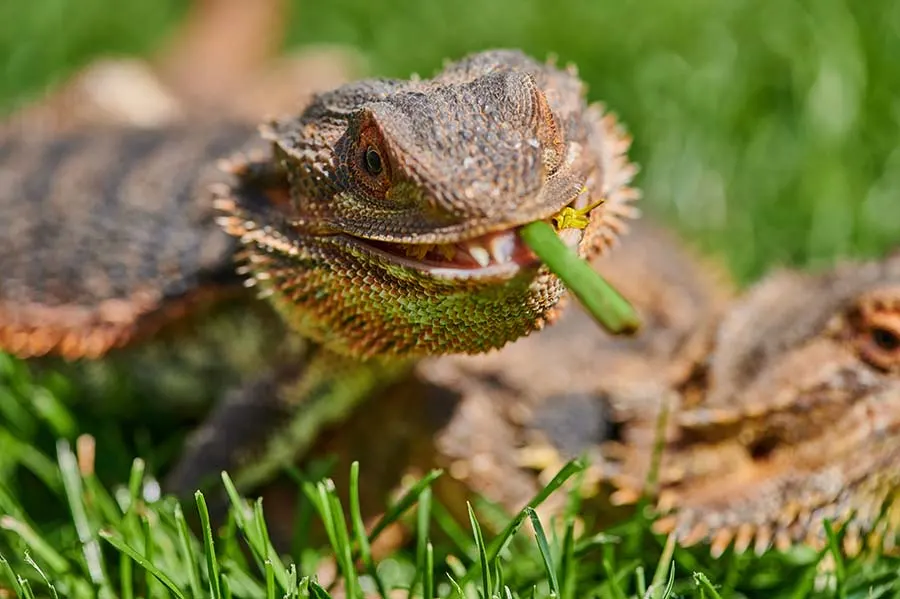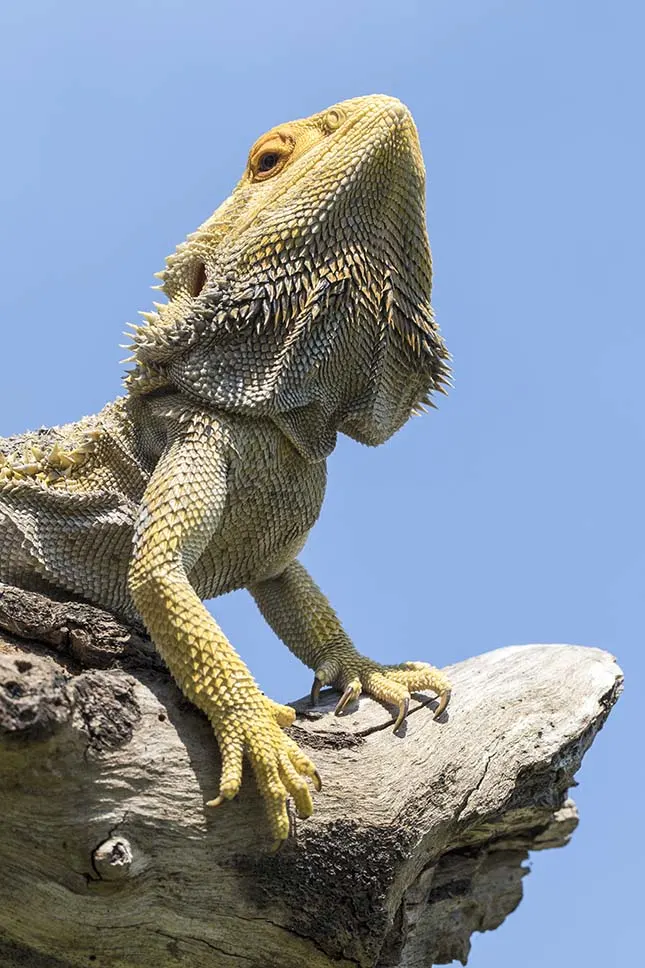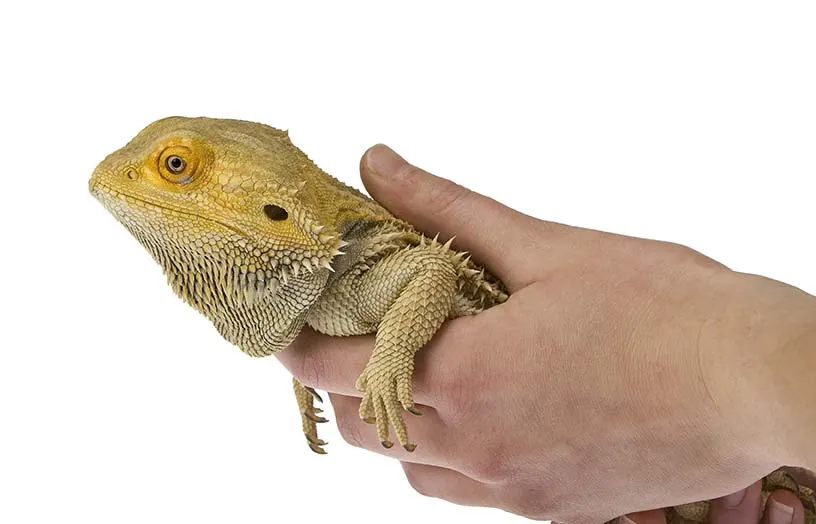When you think of reptiles usually you think of snakes, turtles, and lizards. But you're forgetting a favorite cold-blooded reptilian – The Bearded Dragon! Read on to find out some fun Bearded Dragon facts for kids.

Bearded Dragons are native to the deserts of Australia. In 1990 they became a popular yet unique household pet in the United States. Bearded Dragons continue to be popular because they are quite lovable. Keep reading to learn more fascinating bearded dragon facts.
Bearded Dragon Size
Bearded dragons can grow to be 17-24 inches long. A bearded dragon’s tail is at least the same length as their body – if not longer. Bearded dragons don’t weigh very much though, they only get up to 510 grams which is just over a pound.
Where Do Bearded Dragons Like to Live?
The habitat of a bearded dragon must be warm and dry. Wild Bearded Dragons are native to Australia. In the wild, they like arid areas like deserts, subtropical woodlands, savannas, and scrublands.
Bearded Dragon Diets
Wondering what the favorite food of a bearded dragon is? The ultimate menu for a bearded dragon would include live mealworms, wax worms, and crickets. They also enjoy leaves, flowers, fruit, and the occasional small lizard or rodent. Bearded dragons are omnivores, so they can survive on eating plants or animals.

What Do Bearded Dragons Like to Do in Their Free Time?
The habits of a bearded dragon are typical to most reptiles. Bearded Dragons only eat once a day. So, what do they do with all the extra free time? The typical day of a bearded dragon includes soaking up some sun, taking a nap, watching what is happening around them and having a bite to eat. But you might be surprised about these other bearded dragon facts for kids.
- Male bearded dragons will battle if they feel threatened. During a battle, a Bearded Dragon’s beard puffs up to make them look bigger.
- Bearded dragons take long naps during brumation. Bearded Dragons will brumate for one to three months. The best time of year to find a Bearded Dagon brumating is from June – September. Brumating is like hibernating for reptiles.
Should I Get a Pet Bearded Dragon?
Bearded dragons look fierce, but they are actually very friendly reptiles. Unfortunately, you can’t really snuggle up with a bearded dragon the same way you would a puppy or kitten. But they are quite gentle creatures. Bearded Dragons get calmer as they grow older.

Bearded Dragon Lifespan Facts
The lifespan of a bearded dragon depends on if they are in captivity or living free. In captivity with excellent care, a bearded dragon could live 10-15 years or maybe longer. In the wild Bearded Dragons have many natural predators reducing their average lifespan to 5-8 years.
Important Tips For Pet Owners
Although bearded dragons are low maintenance, they still need regular care. Anyone considering a bearded dragon pet should be sure to follow these bearded dragon care tips.
Offspring
Bearded dragons can lay as many as 20 eggs during a “clutch,” which is basically a cycle. They can have 4-5 clutches a year.

Who are the Bearded Dragon’s Predators?
Like all animals, the bearded dragon has predators out in the wild. Some predators of the Bearded Dragon include feral cats, gull-billed terns, birds of prey, black-headed pythons, dingo, and goannas (Australian monitor lizards)
Classification/Taxonomy
Class: Reptilia
Order: Squamata
Suborder: Lacertilia
Infraorder: Iguania
Family: Agamidae
Sub Family: Agaminae
Genus: Pogona

10 Unusual Bearded Dragon Facts for Kids
- Bearded dragons stay awake during the day. Some lizards are nocturnal (active during the night), but Bearded Dragons are diurnal (active during the day)
- Bearded dragons show their moods You might be able to guess what kind of mood a bearded dragon is in by its color. For example, Bearded dragons turn the color black when they feel stressed, angry or unhappy.
- Bearded dragons have food allergies. Surprisingly the bearded dragon has a food aversion! Bearded Dragons must stay away from eating fireflies and avocados! In fact, these two foods are extremely poisonous to the Bearded Dragon.
- Bearded dragons do not have beards. Their “beards” are actually spiny scales that puff under the necks and darken to resemble a beard.
- Bearded Dragons look fierce, but are friendly. They might not look like it but the Bearded Dragons is a friendly, gentle, and inquisitive creature.
- Bearded dragons can wave hello! Bearded dragons have the ability to recognize other familiar bearded dragons and send a hello. They have also been known to wave hello to their human friends as well. They wave by lifting their leg up and moving it in a circular arch. Similar to what we do when we recognize a friend at the store!
Want to see a bearded dragon wave? Watch this!
- Nicknamed Beardies! Bearded Dragons pets are also known as ‘beardies’ to their owners. What nickname do you like to go by?
- Bearded Dragons can be bicephalic (meaning two-headed). Bicephaly is when animals are born with 2 heads and continue to survive just like non bicephalic animals. It is more common for reptiles to have two heads then mammals.
- Bearded dragons are fast. They appear to be lazy and slow as they sunbathe but they are actually quite quick when they need to be! Bearded dragons can run 9 miles per hour.
- Beardies like long walks in the park. It’s true! You can actually put your bearded dragon on a leash and go for a walk in the park.
I hope you enjoyed all these bearded dragon facts for kids!
So, what is your new favorite thing about bearded dragons? I was definitely surprised about their ability to wave!
